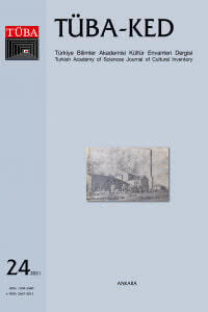ṬUR ʿABDIN’DEKİ SÜRYANİ MİMARİ MİRASININ KORUNMASI: SÜREÇLER VE FARKLI EĞİLİMLER
Azınlık, Kimlik, Koruma, Yeni Kültürel Miras Teorileri
PRESERVATION OF THE ARCHITECTURAL HERITAGE OF THE SYRIAC CHRISTIANS IN THE ṬUR ʿABDIN: PROCESSES AND VARYING APPROACHES
Minority, Identity, Conservation, New Heritage Theories,
___
- BELL, Gertrude. L. and MUNDELL MANGO, Marlia, 1982. The churches and monasteries of the Tur Abdin with an introduction and notes by M. Mundell Mango. London: Pindar Press.
- BİLGE, Yakup, 2011. Mor Gabriel: 1600 yıllık gelenek. İstanbul: Gerçeğe Doğru Kitapları.
- BROCK, Sebastian, 2012. “The Monastery of Mor Gabriel: A Historical Overview and its Wider Significance Today”, editors P. H.Omtzigt, et. al. The Slow Disappearance of the Syriacs from Turkey: And of the Grounds of the Mor Gabriel Monastery: 181-201. Berlin: Lit Verlag.
- HARRISON, Rodney, 2010. “Heritage as a Social Action”, editor S. West. Understanding heritage in practice: 240- 276. Manchester and Milton Keynes: Manchester Univ Press.
- HARVEY, David. C. 2001. “Heritage Pasts and Heritage Presents: temporality, meaning and the scope of heritage studies,” International Journal of Heritage Studies 7 (4): 319- 338.
- HOLLERWEGER, Hans, 1999. Turabdin: living cultural heritage: where Jesus’ language is spoken. Linz: Freunde des Ṭur ʿAbdin.
- HOLTORF, Corneliusand FAIRCLOUGH, Graham 2013. “The New Heritage and re-shapings of the past”, editor A. Gonzalez-Ruibal.Reclaiming Archaeology, Beyond the tropes of Modernity: 197-210. London: Routledge.
- KESER-KAYAALP, Elif. 2013. “Églises et monastères du ṬurʿAbdin: les débuts d’une architecture (syriaque)” F. Briquel Chatonnet. Les églises en monde syriaques: 269-288.
- MYDLAND, Leidulf and GRAHN, Wera 2012. “Identifying heritage values in local communities,” International Journal of Heritage Studies 18 (6): 564-587.
- MUNOZ VINAS, Salvador. 2005 Contemporary Theory of Conservation. Oxford: Elsevier.
- MUNDELL, Marlia, 1981. “The sixth century sculpture of the monastery of Deir Zafaran in Mesopotamia”, Actes du XVe Congrès International D’études Byzantines. Athènes1976: 511-28.
- MUNDELL, Marlia and HAWKINS, Ernest. J. 1973. “The Mosaics of the Monastery of Mar Samuel, Mar Simeon, and Mar Gabriel near Kartmin with A note on the Greek inscription by C.Mango”, Dumbarton Oaks Papers 27: 279-296.
- OBERKAMPF, Horst 2012. “Almost a miracle- Syriacs are returning to their homelands” editors P. H.Omtzigt, et. al.The Slow Disappearance of the Syriacs from Turkey: And of the Grounds of the Mor Gabriel Monastery: 121- 139. Berlin: Lit Verlag.
- RABO, Gabriel 2013. “Batı Diasporasında Süryaniler ve Süryani Kilisesi,” Mukaddime 7: 101-122.
- SMITH, Laurajane 2006. Uses of Heritage. London:Routledge.
- SMITH, Laurajane 2015. “Theorising museum and heritage visiting” editors Message, Kyleand Witcomb, Andrea. Museum Theory: An Expanded Field: 459-484. Oxford: Blackwell Wiley.
- TEULE, Herman 2012. “Who are the Syriacs?” editors P. H. Omtzigt, et. al. The Slow Disappearance of the Syriacs from Turkey: And of the Grounds of the Mor Gabriel Monastery:47-57. Berlin: Lit Verlag.
- TOZMAN, Markus 2012. “Cadastral Registration of Lands and Preservation Orders in Turkey’s South-East: Subtle forms of Discrimination?” editors P. H. Omtzigt, et. al. The Slow Disappearance of the Syriacs from Turkey: And of the Grounds of the Mor Gabriel Monastery:139-157. Berlin: Lit Verlag.
- VÖÖBUS, Arthur. 1975. The Synodicon in the West Syrian tradition. Louvain: Peeters.
- WINTER, Tim 2014. “Heritage studies and the privileging of theory,” International Journal of Heritage Studies 20 (5): 556-572. http://www.suryaniler.com/ (last accessed on 03.06.2016), a website collecting all the news in the media about the Suryani, as well as short articles by some authors.
- ISSN: 1304-2440
- Yayın Aralığı: 2
- Başlangıç: 2003
- Yayıncı: Türkiye Bilimler Akademisi
DÜNYA MİRAS ALANI BURSA’DA FARKINDALIK YARATMA SÜRECİ
Neslihan DOSTOĞLU, Ayten BAŞDEMİR, Birben DURMAÇALIŞ, Eser ÇALIKUŞU
ANKARA İSTİKLAL YAHUDİ MAHALLESİ: TARİHİ, DOKUSU VE KONUTLARI
Deniz AVCI HOSANLI, A. Güliz BİLGİN ALTINÖZ
RUS KAYNAKLARINDA AYASTEFANOS ANITI’YLA İLGİLİ YENİ BULGULAR
ṬUR ʿABDIN’DEKİ SÜRYANİ MİMARİ MİRASININ KORUNMASI: SÜREÇLER VE FARKLI EĞİLİMLER
APARTMAN TİPOLOJİSİNDE GEÇMİŞTEN BUGÜNE; KİRA APARTMANINDAN “REZİDANS’A” GEÇİŞ
